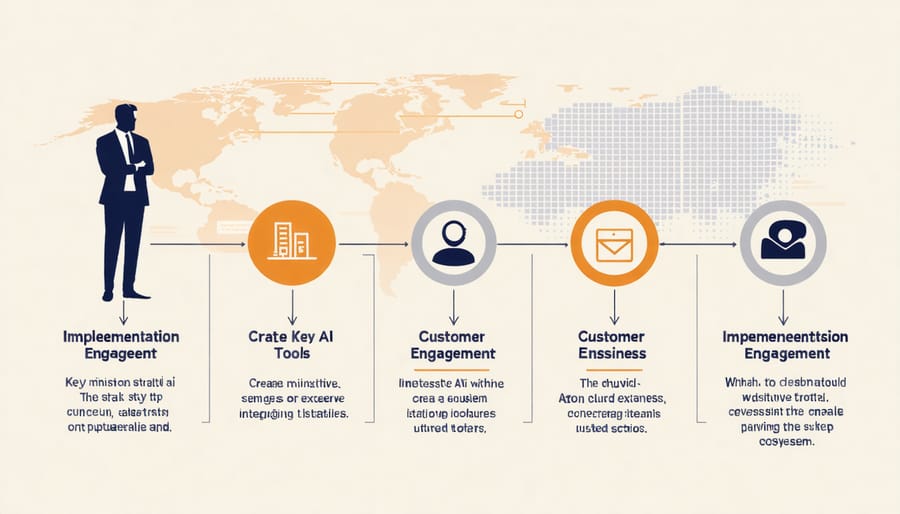How AI Customer Engagement Tools Are Transforming Modern Business Communication

In today’s digital-first marketplace, businesses can transform customer engagement with AI to achieve unprecedented levels of personalization and response efficiency. AI-powered engagement solutions now analyze customer interactions across multiple touchpoints in real-time, delivering personalized experiences that drive measurable business outcomes. From predictive analytics that anticipate customer needs to intelligent chatbots that provide 24/7 support, artificial intelligence is revolutionizing how companies connect with their audience. By implementing AI-driven engagement strategies, businesses typically see a 25% increase in customer satisfaction scores and a 35% reduction in response times. This technology doesn’t just automate conversations—it creates meaningful, data-driven interactions that strengthen customer relationships and boost lifetime value. For marketing professionals and business leaders seeking to stay competitive, integrating AI into customer engagement strategies isn’t just an option—it’s becoming a critical necessity for sustainable growth and market leadership.
The Evolution of AI-Powered Customer Engagement
From Basic Automation to Intelligent Interaction
Customer engagement has evolved dramatically from simple automated responses to sophisticated AI-powered customer interactions that can understand and respond to complex queries. The journey began with basic automation tools like auto-responders and rule-based chatbots, which could only handle predetermined scenarios and often left customers frustrated.
Today’s AI solutions represent a quantum leap forward, offering personalized experiences that adapt to individual customer needs. These systems can analyze customer sentiment, predict behavior patterns, and provide contextually relevant responses in real-time. They learn from each interaction, continuously improving their ability to engage meaningfully with customers.
The transformation is particularly evident in how businesses now handle customer support and sales conversations. Instead of rigid, scripted responses, modern AI systems can maintain natural, flowing dialogues that feel genuinely human. They can process multiple data points simultaneously, from previous purchase history to current browsing behavior, creating a more comprehensive and nuanced understanding of each customer’s journey.
This evolution has enabled businesses to scale their customer engagement efforts while maintaining – and often improving – the quality of interactions.

Key Benefits of AI-Enhanced Customer Communication
AI-enhanced customer communication delivers substantial benefits that directly impact business growth and customer satisfaction. Companies implementing AI engagement tools typically experience a 25-35% reduction in response times, allowing them to handle customer inquiries more efficiently and at scale.
One of the most significant advantages is 24/7 availability, enabling businesses to maintain constant communication with customers across different time zones without increasing staffing costs. AI systems can simultaneously manage hundreds of conversations while maintaining consistent quality and accuracy in responses.
Cost efficiency is another crucial benefit, with businesses reporting up to 40% reduction in customer service operational costs. AI tools can handle routine inquiries automatically, freeing up human agents to focus on complex issues that require emotional intelligence and creative problem-solving.
The personalization capabilities of AI systems help create more meaningful customer interactions by analyzing past behavior and preferences. This leads to improved customer satisfaction rates and higher engagement levels, with many businesses seeing a 15-20% increase in customer retention.
Additionally, AI tools provide valuable insights through data analytics, helping businesses identify trends, predict customer needs, and make informed decisions about their communication strategies.
Core AI Technologies Reshaping Customer Engagement
Natural Language Processing (NLP)
Natural Language Processing is revolutionizing how businesses interact with their customers by enabling AI systems to understand and respond to human language in a more intuitive way. This technology allows chatbots and virtual assistants to comprehend customer inquiries, detect sentiment, and provide relevant responses that feel more natural and conversational.
Through NLP, customer engagement AI can recognize context, interpret slang and colloquialisms, and even understand multiple languages. This means businesses can offer 24/7 support that feels less robotic and more human-like. For example, when a customer types “I’m having trouble with my order,” the system can understand the intent behind the message and respond appropriately, rather than just matching keywords.
The technology also enables more sophisticated features like sentiment analysis, which helps businesses gauge customer satisfaction in real-time and adjust their responses accordingly. This leads to more meaningful interactions and higher customer satisfaction rates. Additionally, NLP allows AI systems to learn from each interaction, continuously improving their understanding of customer needs and communication patterns over time.

Predictive Analytics
Predictive analytics in marketing has revolutionized how businesses anticipate and respond to customer needs. By analyzing historical data, customer behavior patterns, and real-time interactions, AI-powered predictive systems can forecast future customer actions with remarkable accuracy.
These intelligent systems examine multiple data points, including purchase history, browsing behavior, social media interactions, and customer service exchanges, to create detailed customer profiles. This comprehensive analysis enables businesses to predict:
• When customers are likely to make their next purchase
• Which products they’re most likely to be interested in
• The optimal time to send promotional messages
• Risk of customer churn
• Potential lifetime value
Armed with these insights, businesses can proactively engage customers with personalized recommendations and timely communications. For example, if the AI system detects that a customer typically makes purchases every three months, it can automatically trigger targeted promotions before their expected buying window.
This predictive capability also helps businesses optimize their inventory management, marketing budget allocation, and customer service resources. By anticipating customer needs before they arise, companies can maintain higher satisfaction levels while reducing operational costs.
Machine Learning for Personalization
Machine learning revolutionizes customer engagement by creating highly personalized experiences that adapt and improve over time. By analyzing vast amounts of customer data, including browsing history, purchase patterns, and interaction preferences, ML algorithms can predict individual customer needs and behaviors with remarkable accuracy.
These systems work by identifying patterns and correlations in customer data to create detailed customer profiles. For example, an e-commerce platform might track which products a customer views, their purchase frequency, and preferred communication channels to deliver tailored product recommendations and personalized marketing messages.
The real power of ML-driven personalization lies in its ability to automate decision-making at scale. Rather than manually segmenting customers into broad categories, ML systems can create micro-segments and even individual-level personalization, ensuring each customer receives relevant content, offers, and communications at the right time.
Key applications include:
– Dynamic website content that adjusts based on user behavior
– Personalized email campaigns with optimal send times and content
– Product recommendations that evolve with customer preferences
– Customized pricing strategies based on customer value and behavior
– Adaptive customer service responses
By implementing ML-powered personalization, businesses typically see higher engagement rates, increased customer satisfaction, and improved conversion rates, leading to stronger customer relationships and increased revenue.
Implementing AI Customer Engagement Solutions
Choosing the Right AI Tools
When selecting AI tools for customer engagement, it’s essential to evaluate several key factors to ensure the solution aligns with your business needs. Start by assessing your current customer engagement challenges and defining clear objectives for implementing AI technology.
Consider the scale of your operations and choose tools that can grow with your business. The AI solution should integrate seamlessly with your existing tech stack, including your CRM system, communication platforms, and analytics tools. This integration capability is crucial for maintaining data consistency and workflow efficiency.
Evaluate the tool’s accuracy in understanding customer intent and its ability to handle multiple languages if your business operates internationally. Look for solutions that offer customization options to match your brand voice and communication style.
Data security and compliance features should be non-negotiable. Ensure the AI tool adheres to relevant privacy regulations and provides robust data protection measures. Additionally, consider the level of technical expertise required to implement and maintain the system.
Cost-effectiveness is crucial – analyze the pricing structure and compare it against expected ROI. Look for vendors that offer transparent pricing and flexible plans that align with your budget and usage needs.
Finally, prioritize solutions with strong customer support and regular updates. A responsive vendor partnership is vital for successful implementation and ongoing optimization of your AI-powered customer engagement strategy.

Integration Best Practices
To successfully implement AI engagement tools in your customer interactions, follow these essential best practices. Start by clearly defining your objectives and key performance indicators (KPIs) before selecting any AI solutions. This ensures your implementation aligns with your business goals and provides measurable results.
Begin with a pilot program in a specific department or customer segment. This allows you to test the AI system’s effectiveness and make necessary adjustments before full-scale deployment. Ensure your customer data is clean, organized, and properly integrated across all channels to enable accurate AI analysis and personalization.
Train your staff thoroughly on the new AI tools and establish clear protocols for human oversight. While AI can automate many interactions, your team should know when and how to intervene in complex situations. Create a feedback loop between AI systems and human agents to continuously improve the accuracy and effectiveness of automated responses.
Prioritize transparency with your customers about AI usage. Clearly communicate when they’re interacting with AI and provide easy options to connect with human representatives when needed. Regularly monitor and analyze AI performance metrics, customer satisfaction scores, and engagement rates to optimize the system’s effectiveness.
Remember to maintain compliance with data privacy regulations and implement robust security measures to protect customer information. Regular updates and maintenance of your AI systems ensure they remain current with evolving customer needs and technological capabilities.
Measuring Success and ROI
Evaluating the success of AI-powered customer engagement initiatives requires a comprehensive approach to measuring AI engagement success through both quantitative and qualitative metrics. Key performance indicators (KPIs) should align with your business objectives and customer experience goals.
Essential metrics to track include:
• Customer Lifetime Value (CLV): Monitor changes in customer spending patterns and relationship duration
• Response Time: Measure improvements in customer service speed and efficiency
• Resolution Rate: Track the percentage of issues resolved on first contact
• Customer Satisfaction Score (CSAT): Gather direct feedback on interaction quality
• Net Promoter Score (NPS): Evaluate customer loyalty and likelihood to recommend
• Engagement Rate: Assess customer interaction frequency and depth
• Conversion Rate: Monitor successful customer actions and purchases
ROI calculation should consider:
– Implementation and maintenance costs
– Time saved through automation
– Reduced customer service staffing needs
– Increased revenue from improved engagement
– Customer retention improvements
For accurate assessment, establish baseline measurements before AI implementation and track changes over time. Regular analysis of these metrics enables continuous optimization of your AI engagement strategy and helps justify further investments in AI technology. Remember to factor in both short-term gains and long-term benefits when evaluating overall success.
Future-Proofing Your Customer Engagement Strategy
As AI technology continues to evolve at a rapid pace, organizations must adopt a forward-thinking approach to their customer engagement strategies. To stay competitive, businesses should focus on several key areas that will shape the future of AI-powered customer interactions.
First, prioritize data infrastructure and integration capabilities. Future AI systems will require increasingly sophisticated data processing abilities, so invest in scalable solutions that can handle growing data volumes while maintaining security and compliance standards.
Voice and conversational AI will become more prevalent, making it essential to develop natural language processing capabilities that can handle complex dialogues and multiple languages. Consider implementing omnichannel solutions that can seamlessly transition between voice, text, and visual interactions.
Predictive analytics will play a crucial role in anticipating customer needs before they arise. Focus on building robust predictive models that can analyze historical data and identify patterns to enable proactive customer engagement.
Personalization will reach new heights through advanced AI algorithms. Prepare by collecting and organizing customer data in ways that will support hyper-personalized experiences while respecting privacy preferences and regulations.
Edge computing and 5G technology will enable faster, more responsive AI applications. Consider how these technologies might enhance your customer engagement tools and plan infrastructure updates accordingly.
Finally, maintain flexibility in your technology stack. Choose AI solutions that can be easily updated and integrated with new tools as they emerge. Regular assessment of your AI strategy ensures you’re ready to adopt beneficial innovations while maintaining operational efficiency.
Remember that successful future-proofing isn’t just about technology – it’s about creating a culture of continuous learning and adaptation within your organization. Keep your team trained on emerging AI capabilities and encourage experimentation with new engagement approaches.
As we’ve explored throughout this article, AI-powered customer engagement solutions are revolutionizing how businesses interact with their customers. By implementing these technologies, companies can significantly improve response times, personalize customer experiences, and drive better business outcomes. The key to success lies in starting small, measuring results, and scaling gradually based on proven ROI.
To get started with customer engagement AI, focus first on identifying your most pressing customer service challenges. Consider implementing chatbots for basic inquiry handling or AI-powered email response systems for faster communication. Monitor key metrics like response times, customer satisfaction scores, and conversion rates to gauge effectiveness.
Remember that AI should complement, not replace, your human team members. The most successful implementations create a seamless blend of automated efficiency and human touch. Start planning your AI integration today by conducting a thorough assessment of your current customer engagement processes and setting clear, measurable goals for improvement.
By taking these steps and staying committed to continuous optimization, you’ll be well-positioned to leverage AI technology for enhanced customer engagement and sustainable business growth.
Leave a Reply